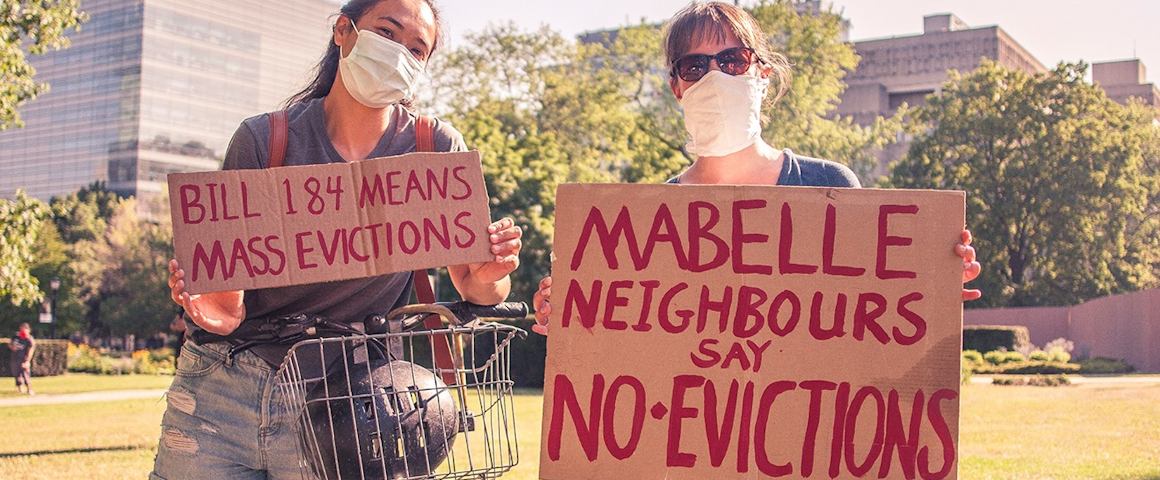By Aliza Kassam
Observing virtual hearings at the Ontario Landlord and Tenant Board (LTB) has been surprisingly disorienting, despite my familiarity contesting landlords’ applications at the tribunal in person.
The burden on tenants, forced into a virtual space created for and managed by the owning class, was clear while I was witnessing my neighbour’s proceeding. For efficiency, this hearing was grouped together amongst others, a chaotic flurry of squares on the screen. The adjudicator jumped back and forth from one case to another, confirming preliminary information with lawyers and tenants – some present by phone and some video. During arguments and testimony by parties, a deep sense of hopelessness lingered among fellow renters on an ominous telecommunication platform, destined for houselessness. Due to improper filing of forms, my neighbour’s landlord’s application was rejected. Although this technicality was hailed as a victory, the landlord would eventually retaliate, file again for unpaid arrears, force an untenable repayment plan and ultimately cause state-sanctioned displacement.
My neighbour was a key tenant organizer in his building, connecting with others facing similar adversities. His countless hours volunteering to share information about tenants’ rights was even more important in a system that does not make this knowledge accessible. His departure is felt throughout this community.
He had the know-how and technology to retain a legal representative for his hearing. Not all tenants are able to advocate for themselves in this way, particularly due to the Ford government’s 30 percent funding cut to Legal Aid Ontario in 2019. I have witnessed vulnerable tenants at hearings unequipped with arguments to keep themselves in their homes. In one hearing I attended, parents of three children tried to strike a repayment plan with their landlord. The father, whose employment had become precarious due to COVID, and the mother, who had to quit her job to care full time for her child with special needs, offered to pay enough arrears in order to cover the landlord’s mortgage payments on their rental house, but no more. In other words, they reasonably requested that the landlord temporarily forego profit while the tenants got back on their feet. This proposal was refused by the landlord.
Beyond the destabilization of community legal clinics, amendments to the Residential Tenancies Act through Bill 184 further disadvantage tenants. Evictions are potentially fast-tracked as repayment plans made outside of the LTB are now permitted, and if there is a breach by the tenant, the landlord can seek an eviction order without a hearing or notice. This means that if a tenant falls into arrears and is pressured into signing something that is ill-understood or unaffordable given the uncertainty of the pandemic, they are essentially signing their own termination of the lease. Worse, if not signed, the landlord can present this plan as evidence that they tried to negotiate. The onus is then on the tenant to justify why they could not agree to the plan by sharing personal information such as current income level and job status. In the virtual abyss, tenants have no idea who is also receiving this information.
The exceedingly difficult terms in many of these repayment plans suggest that some landlords are not concerned with recovering arrears, but that they actually want tenants to default. In the absence of rent control on vacant units, a landlord can reset a new tenant’s rent at whatever the market will bear – quickly offsetting any losses from the previous tenant’s unpaid arrears.
All of this assumes that renters actually make it to their hearing. There have been countless incidents of tenants not showing up, possibly due to not receiving notice, language barriers or technology restrictions. Requesting accommodation to participate, such as having an in-person hearing, requires knowing how and having the technology to submit the required documentation. Logging in to a hearing is confusing, and not all tenants know how to ask for help. Given all these barriers to justice, the majority of tenants who are unable to pay are leaving their homes voluntarily without waiting for notice and are therefore silently and informally evicted.
In hearings where tenants were not present, I have witnessed landlords and adjudicators discuss them in both violating and defamatory ways. One landlord, trying to push out her tenant for non-payment of rent, implied that the house was left in filth and numerous children not belonging to the tenant were often present. This could not be refuted. Video documentation shows an adjudicator waiting only minutes between proceedings of no-show tenants before granting the landlord’s eviction request.
And why would Toronto LTB hearings be procedurally fair? A quick look at adjudicators’ backgrounds suggests a strong appearance of bias, including individuals who are former or current landlord legal service providers. Some are even former police officers. Police are called to forcibly remove tenants in evictions when the sheriffs are unable to do so. Ninety percent of cases at the LTB are landlords primarily seeking to evict tenants due to non-payment of rent, and an impartial hearing stands in the way of profits.
In more recent hearings that I have attended, landlords are refusing to have employee witnesses shown on video during the virtual hearing, citing cyberbullying and harassment by tenants.
Community members exposing those who are driving the housing crisis does not constitute “cyberbullying” or “harassment.” These acts are protected by the Charter of Rights which protects freedom of expression for political participation. Further, how can the credibility of a witness be adequately assessed by parties at the tribunal without seeing the witness? How can the public bear close analysis to these hearings when representatives are refusing to show themselves? Ontario plans to “accelerate access to the justice system” by using a “digital first strategy.” This means switching to permanent online LTB hearings. Allowing those who profit off evictions to shamelessly hide from public view has far-reaching implications.
The spirit of the open court principle suggests that public observation is fundamental to the integrity of a proceeding. Yet, in the proposed omnibus Bill 276, Supporting Recovery and Competitiveness Act, anyone taking and disseminating photographs, recordings and records during LTB proceedings can be charged up to $25,000. The LTB has already threatened to remove unauthorized footage from social media and this absurdly high fine will only serve to further disincentivize tenant organizing. Less transparency results in less accountability, and it is up to organized tenants and housing advocates to continue to share the prejudicial and predatory occurrences at the LTB, particularly in light of the novel virtual hearings. If it not for early recordings at the LTB posted on social media, exposure of what adjudicators’ themselves have referred to as the “eviction blitz” would not have occurred.
As workplaces become increasingly virtual, traditional sites of class struggle are fractured. This systematic isolation also manifests itself in diminished access to justice, intensified repression of organizing, and the mass displacement of tenants from their communities. Whether Bill 276 is passed or not, as virtual LTB hearings become the standard, advocates will have to become more innovative in their tactics for housing justice. This includes applying collective pressure through tenant unions and facing police – the armed wing of the state – head-on through tenant defence. The need to expropriate land and buildings from corporate landlords must be taken up as a viable and just option to create more housing.
Like thousands of people in the city, my neighbour has been pushed out. But due to his efforts, he leaves behind a neighbourhood better equipped to come together and seize power.
[hr gap=”10″]
Get People’s Voice delivered to your door or inbox!
If you found this article useful, please consider subscribing to People’s Voice.
We are 100% reader-supported, with no corporate or government funding.




